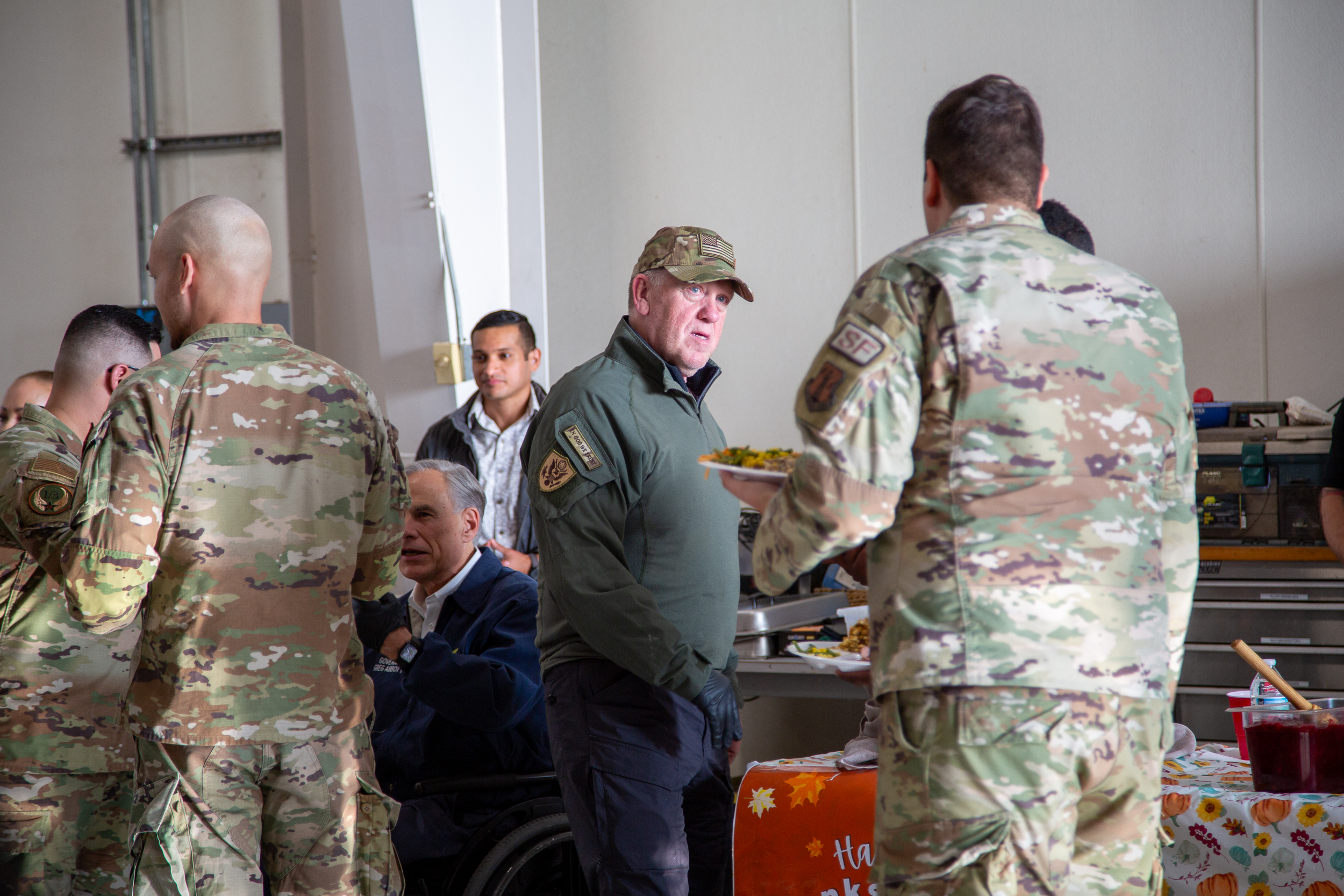Two days before Thanksgiving, Texas Governor Greg Abbott jetted around deep South Texas to brag about his border security bonanza and pose for pictures with soon-to-be federal deportation czar Tom Homan, as the two served National Guard members and state troopers turkey, bread rolls, and cranberry sauce out of cafeteria-style containers. For the agencies of the soldiers and police, this was the fourth Thanksgiving of Abbott’s Operation Lone Star.
Before the grub, Abbott and Homan served up a generous helping of anti-immigrant bravado inside an Edinburg aircraft hangar.
“This is an unprecedented attack on our country,” Abbott said, misleadingly portraying immigrants as criminal invaders. “There’s help on the way, help unlike what any of y’all have ever, ever seen before,” he said, as Homan stood behind him, dressed in an olive-green windbreaker decorated with a Punisher skull patch bearing his surname. “The cavalry is here.”
As this so-called cavalry—the massive immigration crackdown pledged by President-elect Donald Trump—arrives, a question has emerged for Texas taxpayers. For the last decade, state Republicans have flooded the Texas-Mexico divide with border security spending, but could the financial tide finally turn under Trump 2.0?

With the help of his soon-to-be advisors and cabinet members, including Homan and U.S. Customs and Border Protection commissioner nominee Rodney Scott, Trump has promised to shut the border to immigration and deport millions of undocumented U.S. residents, which will likely terrorize communities well into the country’s interior, separate families, and devastate critical sectors of the economy like construction and agriculture.
Abbott has signaled willingness, once the incoming administration ramps up its own border militarization, to cut security expenditures under Operation Lone Star, the governor’s $11 billion multi-agency border scheme. At a press conference last month, he told reporters that Trump will provide Texas the opportunity to redirect funds: “It could be for education, it could be for property tax cuts and sending it back to the people in the state of Texas,” Abbott said, as reported by the Dallas Morning News.
Lieutenant Governor Dan Patrick echoed the same sentiment in a WFAA-TV interview last month. “We’re going to be able to take a lot of that money now and put it back to our taxpayers, for roads, for water, for education, for health care,” he said.
But some doubt that will happen, or hope it won’t. Operation Lone Star has boosted the budgets of local law enforcement agencies, and it has proved especially popular with leaders in smaller, rural counties, where cops have to serve communities across large swaths of land, police budgets are more modest, and local governments have more difficulty bringing in revenue.
Roy Boyd, the sheriff of Goliad County, which sits about halfway between Laredo and Houston, is one such leader who opposes cuts to border security spending. He has his eyes set on policing projects beyond the borderlands.
“If we secure the borders and fail to secure the interior, we will have wasted our time and treasure,” Boyd told the Texas Observer.
Boyd, a Republican, is the chair of a multi-county drug interdiction task force named after and funded by Abbott’s Operation Lone Star, which now foots some of Goliad’s bill for major expenses like personnel costs. Using border security funds, Boyd said his office employs five deputies who largely focus on “investigative services specifically directed at transnational criminal organization activities.” His deputies do this work not only in Goliad, Boyd told the Observer, but for any of the 52 member agencies of the Operation Lone Star Task Force when asked. Not only does Operation Lone Star fund personnel, but it has paid for surveillance tech too: Last year, Boyd’s department acquired a software that can track cell phone locations without a warrant, which he said the department uses for drug and human trafficking investigations.
Some Democratic sheriffs feel the same, in part because their departments also benefit from the influx of border cash. Maverick County Sheriff Tom Schmerber, whose jurisdiction has been the crown jewel of Operation Lone Star and been thrust into the international spotlight over the growing militarization of Eagle Pass, does not want to see changes to Operation Lone Star funding. If Texas cuts border security spending, Schmerber said, “It’s not very good news for me.”
Some opponents of Texas’ ballooning border security industrial complex would support a spending decrease—but they’re skeptical. Agency appropriations requests and bills filed ahead of the 2025 legislative session, two experts told the Observer, suggest Texas is unlikely to actually slow down.
“Judging from the bills filed as is, we’re going to spend an enormous amount of money on so-called ‘border security’ efforts,” said Jaime Puente, director of economic opportunity at the progressive think tank Every Texan.
The governor is asking lawmakers for roughly $3 billion for Operation Lone Star over the next biennium, mostly for building border barriers and migrant busing operations, according to his office’s legislative appropriations request. “Until the border is secured by the federal government, the Office of the Governor believes that overall funding for border security should not be decreased,” his office wrote in the request. “During the 89th Legislative Session, the Office looks forward to the Legislature weighing in during robust conversations on how to best keep Texans safe as we work together to determine the necessary funding to achieve this paramount mission.”
The Department of Public Safety (DPS) and the Texas Military Department (TMD) are the two main agencies at the forefront of Operation Lone Star. In its current appropriation request, DPS is asking for around $1.5 billion for “OLS and Trooper Deployment” and “Border Transportation.” TMD is requesting about $2.3 billion for “State Active Duty – Disaster,” which is the funding source used for Operation Lone Star. TMD did not respond to an Observer request for comment.
Altogether, these requests would amount to a similar or greater level of border security spending than what legislators budgeted in the previous biennium.
Abbott’s GOP allies have also pre-filed bills for big-dollar border-related initiatives, including creating a database of undocumented children and a new state police unit dedicated to patrolling the border.
Plus, significantly cutting spending wouldn’t make sense for Republicans’ goals, Puente said: Texas has already built up a massive infrastructure for border policing and mass deportations. “For the time being, at least in this upcoming legislative session, I do not expect the governor or members of the House Appropriations or Senate Finance [committees], budget writers, to back off at all on what they have already planned, what they’ve already been doing for so-called border security,” Puente said.

Abbott’s Operation Lone Star came on the heels of other border security spending spikes in Texas. Over roughly the last decade, these outlays increased ninefold. And, over the course of the first Trump administration, this spending only increased.
“Operation Lone Star has always been about politics for Gov. Abbott, not about solutions. The project has been a billion-dollar strain on our state for years with few verifiable results,” state representative Armando Walle, a Democrat from Houston, told the Observer in a written statement.
“I’m not optimistic about the future of border spending under another Trump Presidency, but I hope that next session appropriators and legislators in the state Legislature are able to work on common sense solutions and provide resources to the local governments and community organizations in our border counties.”

No comments:
Post a Comment